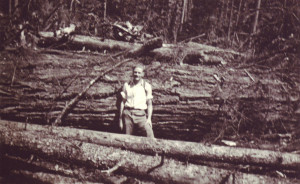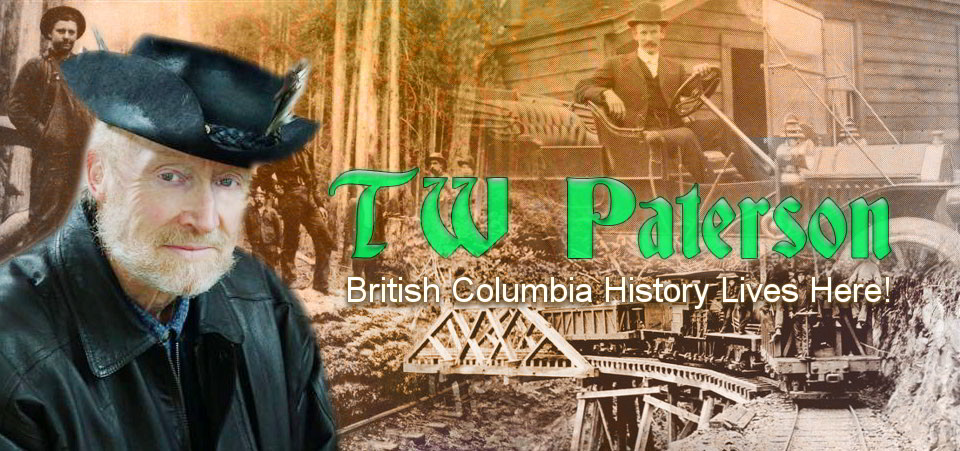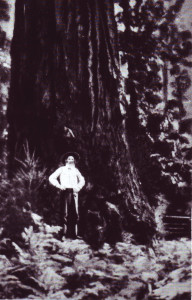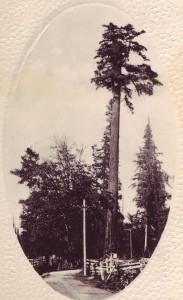‘Second Largest’ Douglas fir recalls Westholme giant
For years, environmental groups such as the Western Canada Wilderness Committee have been urging the provincial government to identify the 100 largest and oldest specimens of each of B.C.’s tree species and legislate protection for them.
Sadly, even should they succeed, it will be a matter of closing the barn door after the horse has bolted. Other than a few notable exceptions, those trees which will qualify for this register are unlikely to be truly representative of the biggest and best of their species at this late date. Just those which have escaped the logger’s axe or Mother Nature’s tempests.
There was a time within living memory when the Westholme Valley, between Duncan and Chemainus on the Island Highway, would have made such a list. Long before the arrival of the first white settlers, the ‘Old Guardsman’ was a giant among its peers. From the ground level to its first branch where it had been snapped off in a storm, it measured 180 feet, and it was estimated that it would have stood about 300 feet tall.
At ‘breast height’ (four feet, six inches), it was 17 feet in diameter and, at its roundest, 52 feet in circumference. Although this pales somewhat alongside a fir in the Lower Mainland’s Lynn Valley which measured 417 in height and 25 feet in diameter, and a Vancouver fir said to have been 415 feet tall, Westholme’s giant was a worthy contemporary.
To put these dimensions in context, these firs ranked with California’s famed Sequoias!
Situated at Joe Richard’s front gate on the old Island Highway, today’s Westholme Road, the giant fir inspired Mount Sicker mining entrepreneur Henry Croft to suggest that it be cut down so that a cross-section might be submitted to the British Colonial Expedition then being held in London. Although nothing came of his proposal, the Westholme Tree, as it was known, was already doomed by rot. Within a decade Richards had to resign himself to bringing it down as it posed a threat to life and limb.
No doubt much to his relief, Fate and Mother Nature did the job for him. On Nov. 24, 1913, the day before he was to go to work, the tired giant simply fell over. Although it blocked the highway and had to be limbed and bucked by hand, Richards had been spared hours of back-breaking toil with spring-board and an aptly-named ‘misery whip.’ Some of it was milled and used in the construction of a house, the rest burned as firewood. A short length of it, very rotten now and likely the top section, can still be seen on the east side the road.
Fortunately for the record, Richards took a ring count from a cross-section which revealed it to be 1500 years old.
The late Allan Gadsden, who lived most of his life in the Westholme area, recalled another forest giant on the slopes of Mount Sicker, so tall that it was used as a landmark by ships sailing the Inside Passage. About 1940, Albert Holman took him up the mountain for a close look. When Allan saw it again, years later, it was on the ground, having been abandoned by loggers who’d found that, even after they’d bucked it into shorter lengths, it was too large for their railway cars.
 The Mount Sicker fir was too big to be moved.
The Mount Sicker fir was too big to be moved.
It must be remembered that loggers’ interest in statistics was limited to board feet–the corporate bottom line–not which was the tallest or the oldest, so it’s very unlikely that serious attention was given to their full dimensions. Nevertheless, official forestry records honour a Douglas fir felled in the Cowichan Lake area in 1959 as having been an incredible 1266 years old. Meaning that it was a seedling just seven centuries after the birth of Christ and almost 800 years before Columbus sailed on his voyage of discovery to America.
A Sitka spruce near Port Renfrew is thought to be the second largest spruce in the world. Also near Renfrew is the landmark Red Creek Fir which, broken off at the 242-foot mark, is believed to have originally exceeded 300 feet in height and to be 900 years old. Forty years ago, the B.C. Forest Service honoured a Western Red Cedar cut down in the Vancouver area as having been “the largest (B.C.) tree of any species” with a butt of 18 feet in diameter.
The late Gerald Wellburn, founder of what is today’s B.C. Forest Discovery Centre, unofficially estimated a stand of firs in the Koksilah River watershed to be 1300 years old. And big enough that, 20-plus years ago, loggers working for Fletcher Challenge refused to fall them. This stand, which includes an 81-metre Douglas fir and a 71-metre grand fir, is now owned by TimberWest and is again the subject of a populist campaign to save them for posterity.
As it happens, the Cowichan Valley makes the Register of Big Trees in British Columbia no fewer than 10 times:
A Pacific dogwood in Shawnigan Lake Provincial Park, five Garry oaks in the Quamichan Lake and Somenos Road areas, three Pacific yews at the south end of Shawnigan Lake, and a Pacific pine at Lake Cowichan.
In 2009 the Western Canada Wilderness Committee urged the provincial and federal governments to jointly finance a $40-million-a-year fund “to buy old-growth forests and endangered ecosystems”. WCWC campaign director Ken Wu told the Times-Colonist: “These fights over old-growth forests on private forest lands will occur again and again…until [both governments] put aside the funds to systematically buy up the private lands for new protected areas–or until the last of the unprotected old-growth stands are logged.”
For Vancouver Island in particular, he suggested that the fund could be supported through increased stumpage fees charged to the private holders of three major tree farm licenses, Timber West, Island Timberlands and Western Forest Products, or by means of a parks levy such as homeowners pay in the Capital Regional District.
More recently, the Ancient Forest Alliance and Ken Wu have lobbied to save a massive stand of old-growth forest near Port Renfrew which has gained international acclaim as Avatar Grove.
‘Big Lonely Doug’
In April 2014, this 1000-year-old Port Renfrew-area Douglas fir was hailed by the B.C. Big Tree Registry as Canada’s second-largest tree: 70.2 metres (230 feet) tall with a base diameter of 3.91 metres (13 feet). This, despite the fact that the Red Creek Fir, just 20 kilometres (12 miles) to the east, is 73.8 metres (242 feet).
Another source claims that Canada’s largest tree is the Cheewhat Giant, a western red cedar near Cheewhat Lake west of Lake Cowichan, whose vitals are: 56 metres (182 feet) in height and six metres (20 feet) in trunk diameter.That’s the equivalent of 450 regular-sized telephone poles!
Despite a report (T-C, February 2011) that then B.C. Forest Minister Pat Bell was “looking at new ways to safeguard ancient trees or groves of forest giants…” the campaign to save many of the last of Nature’s giants and endangered species such as the Garry oak from logging and development goes on.
See also…
More about the Westholme giant
Westholme tree update
14 Comments
Trackbacks/Pingbacks
- Tallest Douglas Fir in America | rephaim23 - […] 350 ft Estimated Height of the big Fir at Westholme, Vancouver Is. BC. Blown down 1913, Estimated to be…



Hi Mr. Paterson,
This is a really great website and information! The Westholme tree had to have been the most impressive Douglas fir to behold, 17 feet diameter, nothing that big exists today. I wonder how tall the Mount Sicker tree was? I added a link to your page on my blog. Thanks!
Micah
Thank you, Micah. Thanks, too, for not being another spammer! Since posting this article I came into possession of a photo showing a fallen tree, likely in the Nanaimo area, with a logger standing beside it. Accepting that he was at least five feet tall, the tree is easily another three feet higher (on its side) than he is.
We’ll never see their likes again, alas. –TW
That’s interesting about the big Nanaimo fir photo! Yeah it’s actually quite hard to believe the size of some of these long gone giant Douglas fir ‘ and reports of fallen trees 300 to even over 400 feet tall with 10 to 19 foot diameters have certainly drawn skepticism in recent years, but the old journal entries, and abundant photos of lumbermen cutting them down are the only reminders we have of them, ”lest we forget.” To be perfectly honest, I can’t think of a single Douglas fir standing today in BC which is over 300 feet high…maybe one in Coquitlam at Meech creek, but it would be nice if a few more where still out there! A couple dozen 300 – 325 footers still remain in Oregon, Washington, and California but 130 years years ago they were felling 13 ft diameter 320 foot firs at present Georgia street, downtown Vancouver…. but I think with renewed interest in historic size records, we can get a better idea of just how big some of those where which got away. Cheers, Micah.
Hi, Micah: The irony is, logging equipment (trucks, etc.) is bigger and brawnier than ever. But the loads of so-called logs (6″-8″ diameter or slightly bigger) that I see every day are pathetic. In fact, it isn’t even logging any more, it’s harvesting.
I’ll be walking some old CNR line on Sunday and I’ll make a point of, as I always do, noticing the tall, notched hand-logged stumps from the first-growth of 80-100 years ago. What a commentary on our managemnt of our natural resources they are! –TW
What a commentary indeed! The loads today look like pixie sticks compared to the old day photos etc. I still see occasional logging trucks with good sized 3 to 4 ft diameter logs going down the Interstate 5 from Portland to Bellingham, but have never seen anything bigger than that. No more of those 1 or 5 log loads. It is refreshing to see a few giants still remain like the recently found ‘Big Lonely Doug’, but I predict that tree will blow over within the next few years, meeting a similar fate to the wind exposed “Koksilah giant” which was measured by Dr. Al Carder back in the 70’s.
We recently were fortunate enough to buy a house on the Rogue River that has 6 majestic Doug Firs on the property! The largest one is 13 ft in diameter and all the rest are almost as large.I understand that there is no way to really tell how old it is but is there an approximate age for a Doug Fir this large? I am beyond joy to be a guardian of these beauties!
Hi, Barbara: 13 feet in diameter–wow! There is a way to determine a tree’s age, but you don’t want to apply it. That’s by cutting it down and counting the rings, each of which is a year’s growth.
To give you an example,on Sunday we walked part of the Trans Canada Trail (originally the Canadian National Railway)in the Cowichan Valley. A maintenance crew had recently bucked a fir that was overhanging the trail. I stopped counting the rings at the 200-mark, some of them 1/16″ wide, meaning slow growth and tight grain. Because this is park, this tree will be left to rot; from a logger’s perspective, it is prime timber.
We also noted a standing fir that we measured as being 8 feet across, the biggest we’ve seen yet on the Trail,which was logged during the ’20s and again more recently judging by the hand-logged vs. chainsawed stumps.
Just a baby compared to your 13-footer, of course.
You may consider yourself blessed! –TW
Wow 13 feet? That has got to be a local record! I have compiled a database of about 200 historic giant Douglas for reports, and a 13 ft for could range in age as young as 500 years old if it has had exellent growth, to as old as 1,300 or 1,400 years if the growth was more regular, so I’d estimate 1,000 years is how old your tree is. Any idea as to how tall it is? Plenty of historic giants of 13 ft have measured from 300 to 350 feet high if their top is still intact.
Thanks for the info. I have no idea how tall it is because I can’t see the top due to the other trees. The squirrels seem to love them as much as I do.!
This is a great site and I will be sure to check for new posts frequently!
What a terrific article! With numbers this big it’s hard to truly appreciate the real scope and scale of what is being discussed here. Suffice it to say that the west coast of Canada is home to some of the grandest trees in the world today! I’ll never look at one of our towering timbers quite the same after reading this article. I pray that someone, somewhere steps up and does the right thing in terms of trying to protect these incredible treasures.
What amazes me, really, is that once upon a time, giants such as these were the norm! If you’ve ever read descriptions of the forests in the Cowichan Lake area, to name one, from the turn of the last century through the 1920s, you’ll realize that B.C.’s first-growth forests were likely without equal on the planet.
Douglas firs and cedars (hemlock didn’t count!)so large that they could be cherry-picked. Time and again, I’ve seen logs that were left by the early loggers for some reason or other that isn’t apparent to my eye. Bucked from trees, I’m sure, that would be eagerly snatched up today rather than left to rot. But they could be choosy in the good old days.
This past Sunday, while hiking the Trans Canada Trail (formerly the CNR), we saw seven massive, bucked logs left from a train derailment. The loggers didn’t have a portable crane, I guess. By today’s standards–then, too, I’m sure–these were prime! What a tragedy that, after being felled, they never even made it to the sawmill which would at least have justified their being cut down. Ah well… –TW
It makes a person want to cry when you think of the wanton destruction of our magnificent forests, but I am thinking that back in the day…whether it be the future Vancouver or the hinterland of our province, there were more trees than you could shake your fist at, who back then would have ever thought we could destroy them all in the name of money…..kind of like the buffalo on the prairies or anything else man has a hankering to destroy. The sheer majesty of these behemoths it so awe inspiring it is like seeing the hand of God.
Believe it or not, forest industry giant H.R. Macmillan said, back about the time of the First World War, that Vancouver Island’s first-growth timber would sustain the forestry industry for 250 years!
As late as the 1920s, others publicly declared that the forests would never run out of timber. Well, we know better, don’t we.
To think that some of those forest giants were around when Columbus ‘found’ the New World… –TWP
You have a great site! Too bad we’ll never know about the ones that “got away” before we started taking notice. –TWP